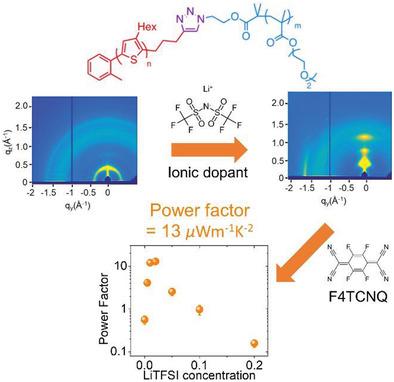当前位置:
X-MOL 学术
›
Adv. Funct. Mater.
›
论文详情
Our official English website, www.x-mol.net, welcomes your
feedback! (Note: you will need to create a separate account there.)
Ionic Dopant-Induced Ordering Enhances the Thermoelectric Properties of a Polythiophene-Based Block Copolymer
Advanced Functional Materials ( IF 18.5 ) Pub Date : 2021-09-15 , DOI: 10.1002/adfm.202106991 Ban Xuan Dong 1 , Ziwei Liu 2 , Jonathan W. Onorato 3 , Tengzhou Ma 1 , Joseph Strzalka 4 , Peter Bennington 1 , Christine K. Luscombe 3, 5, 6 , Christopher K. Ober 2 , Paul F. Nealey 1 , Shrayesh N. Patel 1
Advanced Functional Materials ( IF 18.5 ) Pub Date : 2021-09-15 , DOI: 10.1002/adfm.202106991 Ban Xuan Dong 1 , Ziwei Liu 2 , Jonathan W. Onorato 3 , Tengzhou Ma 1 , Joseph Strzalka 4 , Peter Bennington 1 , Christine K. Luscombe 3, 5, 6 , Christopher K. Ober 2 , Paul F. Nealey 1 , Shrayesh N. Patel 1
Affiliation

|
Conjugated polymer-based block copolymers (CP-BCPs) are an unexplored class of materials for organic thermoelectrics. Herein, the authors report on the electronic conductivity (σ) and Seebeck coefficient (α) of a newly synthesized CP-BCP, poly(3-hexylthiophene)-block-poly (oligo-oxyethylene methacrylate) (P3HT-b-POEM), upon solution co-processing with lithium bis(trifluoromethanesulfonyl)imide (LiTFSI), and subsequently vapor-doping with a molecular dopant, 2,3,5,6-tetrafluoro-7,7,8,8-tetracyanoquinodimethane (F4TCNQ). It is found that the addition of the hydrophilic block POEM greatly enhances the processability of P3HT, enabling homogeneous solution-mixing with LiTFSI. Notably, interactions between P3HT-b-POEM with ionic species significantly improve molecular order and unexpectedly cause electrical oxidizing doping of P3HT block both in solution and solid-states, a phenomenon that has not been previously observed in Li-salt containing P3HT. Vapor doping of P3HT-b-POEM-LiTFSI thin films with F4TCNQ further enhances σ and yields a thermoelectric power factor PF = α2σ of 13.0 µW m−1 K−2, which is more than 20 times higher than salt-free P3HT-b-POEM sample. Through modeling thermoelectric behaviors of P3HT-b-POEM with the Kang-Snyder transport model, the improvement in PF is attributed to higher electronic charge mobility originating from the enhanced molecular ordering of P3HT. The results demonstrate that solution co-processing CP-BCPs with a salt is a powerful method to control structure and performance of organic thermoelectric materials.
中文翻译:

离子掺杂剂诱导的排序增强了基于聚噻吩的嵌段共聚物的热电性能
共轭聚合物基嵌段共聚物 (CP-BCP) 是一类尚未开发的有机热电材料。本文中,作者对电子电导率(σ)和新合成的CP-BCP的塞贝克系数(α),聚(3-己基噻吩)报告-嵌段-聚(低聚氧乙烯甲基丙烯酸酯)(P3HT- b -POEM),与双(三氟甲磺酰)亚胺锂(LiTFSI)进行溶液共处理,随后用分子掺杂剂 2,3,5,6-四氟-7,7,8,8-四氰基醌二甲烷(F4TCNQ)进行气相掺杂。结果表明,亲水嵌段 POEM 的加入大大提高了 P3HT 的加工性能,使与 LiTFSI 的溶液混合均匀。值得注意的是,P3HT- b之间的相互作用-具有离子种类的 POEM 显着改善了分子顺序,并出人意料地导致溶液和固态中 P3HT 块的电氧化掺杂,这是以前在含 P3HT 的锂盐中未观察到的现象。用 F4TCNQ 对 P3HT- b -POEM-LiTFSI 薄膜进行气相掺杂进一步增强了 σ 并产生了13.0 µ W m -1 K -2的热电功率因数PF = α 2 σ, 比无盐高 20 倍以上P3HT- b -POEM样品。通过使用康-斯奈德输运模型对 P3HT -b- POEM 的热电行为进行建模,PF的改进归因于源自 P3HT 增强的分子排序的更高电子电荷迁移率。结果表明,溶液协同处理 CP-BCP 与盐是控制有机热电材料结构和性能的有效方法。
更新日期:2021-09-15
中文翻译:

离子掺杂剂诱导的排序增强了基于聚噻吩的嵌段共聚物的热电性能
共轭聚合物基嵌段共聚物 (CP-BCP) 是一类尚未开发的有机热电材料。本文中,作者对电子电导率(σ)和新合成的CP-BCP的塞贝克系数(α),聚(3-己基噻吩)报告-嵌段-聚(低聚氧乙烯甲基丙烯酸酯)(P3HT- b -POEM),与双(三氟甲磺酰)亚胺锂(LiTFSI)进行溶液共处理,随后用分子掺杂剂 2,3,5,6-四氟-7,7,8,8-四氰基醌二甲烷(F4TCNQ)进行气相掺杂。结果表明,亲水嵌段 POEM 的加入大大提高了 P3HT 的加工性能,使与 LiTFSI 的溶液混合均匀。值得注意的是,P3HT- b之间的相互作用-具有离子种类的 POEM 显着改善了分子顺序,并出人意料地导致溶液和固态中 P3HT 块的电氧化掺杂,这是以前在含 P3HT 的锂盐中未观察到的现象。用 F4TCNQ 对 P3HT- b -POEM-LiTFSI 薄膜进行气相掺杂进一步增强了 σ 并产生了13.0 µ W m -1 K -2的热电功率因数PF = α 2 σ, 比无盐高 20 倍以上P3HT- b -POEM样品。通过使用康-斯奈德输运模型对 P3HT -b- POEM 的热电行为进行建模,PF的改进归因于源自 P3HT 增强的分子排序的更高电子电荷迁移率。结果表明,溶液协同处理 CP-BCP 与盐是控制有机热电材料结构和性能的有效方法。











































 京公网安备 11010802027423号
京公网安备 11010802027423号